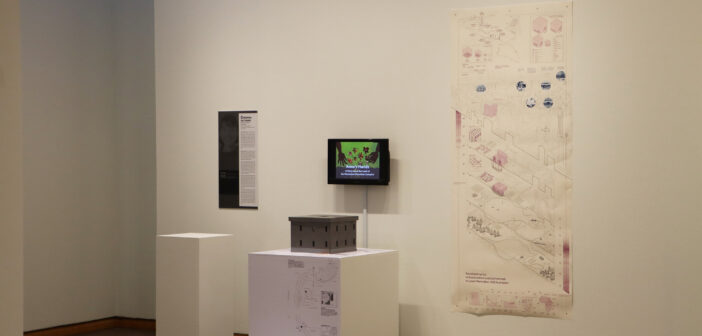In the Lehigh University Art Galleries, there currently sits an exhibit that at first glance presents as a simple box. But, upon lifting the lid that reads “Dismantle Me!,” one will uncover rooms and spaces filled with humanity and compassion.
The interactive artwork, titled “The Seeds of Liberation,” focuses on prison abolition and is centered on three distinct stages or “seeds” of liberation.
Beneath the lid on the exhibit and behind prison bars, birthdays are celebrated, friendships flourish and moments of joy unfold — hidden from view, yet growing, just like seeds beneath the soil.
The artwork was created by Lehigh professors Christina Zhang and Dean Caivano, in collaboration with Clare Fentress, a New York City architect. The opening reception for the exhibit was held on Feb. 4, and it will be on display at the galleries until May 23 among other work created by Lehigh faculty.
“We decided to make it so that people can unpack this experience of approaching prison, seeing it as a monolithic, jarring creature,” Zhang said. “But, then you realize what it’s containing is really just people living their life.”
Zhang teaches art, architecture and design at Lehigh. She said her work focuses on the connection between architecture and social justice, and she often incorporates storytelling to build connection in her art.
Caivano teaches political theory. He said he’s immersed himself in teaching across diverse communities, ranging from community colleges to carceral institutions.
Zhang said the first seed explores the land beneath the “mega jail” in Chinatown, NYC — one of the last remaining ethnic enclaves in the United States. She also said this seed explores the life of Anna d’Angola, one of the first Black women to own land in North America and the original owner of the land where the jail now stands.
The first seed symbolizes what grows beneath the soil and ultimately “breaks the ground,” Zhang said.
A map that’s part of the exhibit reveals that the jail was built on top of a pond, causing constant structural instability.
“The structure of (the prison) keeps failing,” Zhang said. “It’s almost like the ground is trying to just dismantle the prison, which is really awesome.”
Caivano said the monolithic walls of prisons were built to hold and house human life, but behind the walls there are real living humans who, against systems of violence, are carving out spaces of love.
He said this is meant to reimagine the prison — not as a harsh, intimidating place, but as a space filled with individuals forming their own community.
“What we can find, I think really powerfully, really beautifully, in very complex and almost mysterious ways, is that it’s always within these spaces of violence that the seeds of liberation begin to take root,” Caivano said.
Zhang said the second seed highlights the collaboration between her and Caivano, and it offers a glimpse into the life and love that exist within prison walls.
The third seed is a seed bomb made from plant seeds native to Northeast America, Zhang said. It adds to the exhibit’s interactivity by allowing visitors to take the seed bombs home with them.
“The third seed is sort of the interactive bit where you can work with it to take a seed home to start a seed of liberation,” Zhang said.
The instructions encourage visitors to envision the seed bomb’s sprouts pushing through a concrete wall, symbolizing the transformation of confinement into pathways of liberation and hope.
“What it captures very importantly, I think, is that the idea of abolition, particularly prison abolition, is really a crisis of imagination,” Caivano said. “It requires all of us, not just those incarcerated, not just those working at the intersections of the criminal legal system, but all of us, to recognize that what is at stake with abolition is the liberation of life.”
He also said while people might not associate the two areas, he considers political science another form of architecture, and he considers himself a political architect in the ideological sense.
“For me, political science and what I do in the area of politics is just another form of architecture, because to engage in political theorizing is really to investigate how ideas have then been taken up, translated, coded into the very institutions that structure us, the very institutions that govern us and teach us and train us and punish us,” Caivano said.
Angel Castañeda, ‘27, studies architecture and is a student of Zhang’s. He said it has been interesting to see architecture in different contexts between Zhang’s teaching and her work. “It’s just very different how architecture is applied, and it can really be applied to anything,” Castañeda said. “It’s really interesting to see that architecture can really change the notion of prisons.”






Comment policy
Comments posted to The Brown and White website are reviewed by a moderator before being approved. Incendiary speech or harassing language, including comments targeted at individuals, may be deemed unacceptable and not published. Spam and other soliciting will also be declined.
The Brown and White also reserves the right to not publish entirely anonymous comments.